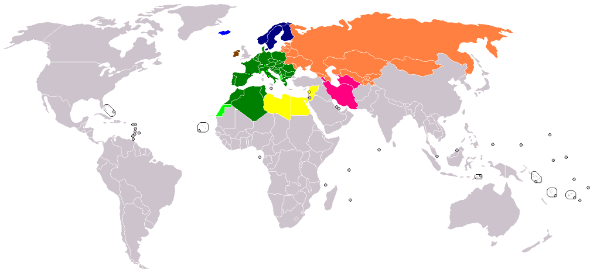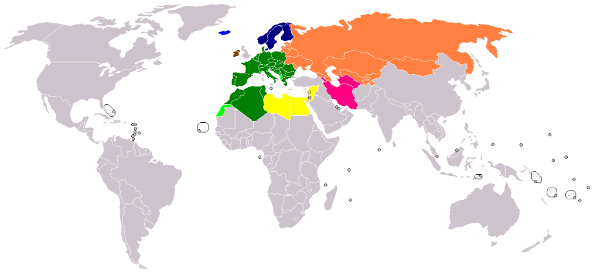The International Dispute That Slowed Down Time

Plug an appliance into a wall socket and you’re going to take for granted, that, absent an outage, electricity is going to flow into your device. But it’s not like the outlet is a magical portal or something like that. It takes a lot of planning, people, and infrastructure to get electricity to wherever you are. For example, there are enormous electrical grids which regulate and deliver electricity over large areas — and sometimes, across borders. For example, here’s a map of power grids in parts of Europe, Asia, and Africa, with each colored area showing a self-contained grid. As you can see, some of them are enormous and cross international boundaries
Having huge power grids has its advantages — low output in one area can be accounted for by supply in other areas. But it can come at a weird cost: it can slow down time. Or, at least, clocks. If you were in the dark green region above, a weird fight over electricity could have made you a few minutes late.
Let’s start by looking at that map again. If you focus on Europe, you’ll note that most of the continent — excluding Scandinavia and the UK, but including part of Northern Africa — is on the same grid, called the “Synchronous grid of Continental Europe.” The grid powers the homes of more than 400 million people across two dozen or so nations. If there’s a lack of power in Italy, for example, that can be accounted for by additional output from, say, Poland. Having one interconnected network allows for that.
But the Continental European grid isn’t entirely centralized. There are a handful of regional control areas which are responsible for balancing the local output with local needs, with the goal of keeping everything even. The entire European grid runs at a unified frequency of 50 Hz, or fifty currents of electrical cycles per second, and usually, regional disruptions — which are rare to begin with — are solved at the regional level. And usually, everyone gets along and power flows without concern.
Unfortunately, that doesn’t take into account some bad blood between Serbia and Kosovo. Prior to 2008, Kosovo was part of Serbia, but the former declared its independence in February of that year. Most countries recognize Kosovo’s claim to independence but there are many that do not, with Serbia chief among them. Usually, this doesn’t matter — except when it comes to power. In that case, Kosovo most definitely is not free from Serbian control — both nations are part of the Continental European grid, and regional control of both is situated in Serbia.
In early 2018, Kosovo was consuming more electricity than it could produce. As the New York Times reported, “a power plant in Kosovo, a former province of Serbia, went down for repairs, causing a shortfall in the power supply. Serbia, which still controls Kosovo’s transmission system, has refused to make up the difference [without payment], despite an agreement to do so.” Seemingly innocuous — or, in the very least, a very localized issue. But again, most of Europe has one big grid. Serbia accounted for the power imbalance by dropping the frequency a bit, and in total, per Reuters, “the European network’s frequency had deviated from its standard of 50 Hertz (Hz) to 49.996 Hz” from mid-January through early March.”
That sounds like no big deal — who would notice? Few, if any, people would. But clocks aren’t people. They’re machines, and they need something to tell when to move from this second to the next. And many electric clocks — e.g. bedside alarm clocks or the one on your microwave — rely on the power grid for that information. Wired explains: “As 50Hz means 50 cycles of the current per second, the [clocks’] internal mechanism ‘ticks’ whenever it measures 50 cycles. However, when the frequency slowed, this meant that these clocks slowed down too.” These clocks were losing 0.00008 seconds per normal second, which added up to about six minutes over the course of the Serbia-Kosovo imbroglio. An electric clock in Germany, France, or Portugal would read 9:54 while a quartz one next to it would read 10:00 — all because of a dispute between two other nations stemming from 2008.
According to a follow-up report by Reuters, the problem has been temporarily solved since. Kosovo’s government reallocated budget to purchase more power, eliminating Serbia’s incentive to slow down the output. But the problem may return if those payments stop flowing.
Bonus fact: The United States has three power grids (for the most part) — one for the Eastern part of the country, one for the Western part, and one for Texas. Why does Texas have its own power grid? The state’s reputation for having an overheated independent streak is probably part of it, but there’s a practical reason why, too. Texas’ original power grid was built in World War II, supporting factories vital to the American war effort. As Slate explains, “the state’s electricity planners—anxious to keep the assembly lines running and concerned about the reliability of the power supply—felt that a Texas-only system would be more dependable than one that harnessed electricity from distant states.”
From the Archives: Land of Darkness: North Korea’s power grid isn’t much of one.
